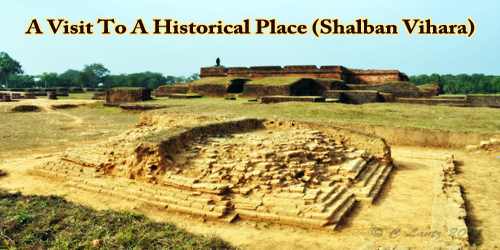Shalban Vihara (Bengali: শালবন বিহার Shalban Bihar) is among the most important excavated sites in Mainamati, Comilla, Bangladesh. It lies about the middle of the Lalmai ridge in the vicinity of the present-day Bangladesh academy for rural development at Kotbari near Comilla. Excavations have exposed a large paharpur type Buddhist monastery and other material objects datable from the 7th to 12th centuries AD. Formally arranged in four wings around a central shrine, this 167.6m square monastery contains a total of 155 cells. Originally, the monastery was called Bhavadev Bihar after the king, but today the Shalban name comes from a grove of Shal (shorea robusta) trees. Its single entrance in the middle of the north wing is set in a grand 22.6m wide front facade with guardrooms projected outwards. All the walls of the monastery are solid and massive, the back wall being the most massive, 5m thick. This feature, together with the forbidding character of the single gateway with its guardrooms, and the dreary look of the massive outer wall, must have given it the appearance and utility of a citadel necessitated by the increasing wealth of these establishments and the insecurity of the period.
Bangladesh is a heartland of many renowned Buddhist heritage sites. In Bangladesh, some discoveries have been made on Buddhism, which are very significant. Shalban Viahara in Comilla is one of the most important archaeological discoveries. The discoveries have added substantially to our knowledge of the history and chronology of ancient Bangladesh and various aspects of her Buddhist life and culture. Before 1200 years ago the King Bhava Deva, the fourth ruler of the Early-Deva dynasty built that place on 168 square meters of ground. It was the royal palace for the early Buddhist students. This site, previously called Shalban Rajar Bari, came out after archaeological excavation as a Buddhist monastery and hence termed as Salban vihara from the terracotta seals and copper plates discovered. Its original name is supposed to have been Bhava Deva Mahavihara after the 4th king of the early Deva dynasty which ruled this region from the mid-7th to mid-8th centuries AD. It was built in or on the outskirts of Devaparvata, the Samatata capital bordering the Lalambi forest.
The Central Shrine at Shalvan Vihara consists not of one but six different structures built successively on the same spot in different periods and on different plans. They provide interesting evidence of the evolution and gradual transformation of traditional Buddhist stupa architecture into that of the Hindu temple. The Cruciform Shrine It is an exceedingly interesting piece of architecture resembling in ground plan a Greek cross, 51.8m long, with chapels built in the projecting arms. Its basement walls are embellished with a stringcourse of delightfully sculptured terracotta plaques set within parallel bands of ornamental bricks. This shrine bears a striking resemblance with that of Paharpur and represents a fully developed and finished example of the 7th-8th century Buddhist temple architecture of Bengal. The finds from excavations at Shalban Vihara have been very rich and valuable which include seven copper-plate inscriptions, about 350 golds, and a large number of sculptural specimens in stone, bronze, and terracotta, and innumerable terracotta sculptured plaques found both in situ and otherwise. This was once a self-contained Buddhist monastery where, monks lived, studied, and prayed. It was the royal palace for the early Buddhist students. Students from various places come here for their meditation and religious learning. During their study period, the students stay in the dormitory/cells around the temple. It’s such a quiet place inside a barren forest and one of the greatest tourist spots in Bangladesh. Every year many tourists from home and abroad visit Shalban Vihara to know the archaeological values of this site. Department of Archaeology has established a site museum near the site to display the relics found in and around the Shalban Vihara. The government of Bangladesh has taken initiatives to inscribe Shalban Vihara as a World Heritage Site.
















